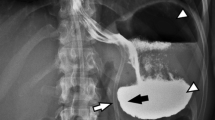Abstract
Background
Pouch enlargement and band slippage are the most common late complications of laparoscopic adjustable gastric banding (LAGB). Often, confusion exists among surgeons regarding the denomination or even the treatment of these two different entities. This study aimed to establish the differences in clinical presentation, radiologic features, and management between pouch enlargement and band slippage. The authors hypothesized that pouch enlargement can be managed nonoperatively (via band deflation), that band slippage is an acute complication requiring surgical treatment, and that tailored adjustment allows earlier diagnosis of pouch enlargement in asymptomatic patients.
Methods
From March 2001 to December 2004, 516 patients underwent LAGB placement. Barium swallow was performed preoperatively, postoperatively, and during band adjustments (“tailored adjustment”). Pouch enlargement was defined as dilation of the pouch, and band slippage was considered when band and stomach were prolapsed. Four radiologic types of pouch enlargement were considered: band 45°, band 45° with covering of the band, band 0°, and band smaller than 0°.
Results
A total of 1,600 barium swallows were performed with 516 patients. As a result, pouch enlargement was diagnosed for 61 patients (12%) and band slippage for 12 patients (2%).
Conclusion
In this study, pouch enlargement was found to be a chronic complication that can be managed conservatively with a 77% success rate. Tailored adjustment allows early diagnosis of pouch enlargement, thus preventing adjustments in patients with undiagnosed pouch enlargement. Surgical treatment should be considered when medical treatment fails. By comparison, band slippage is an acute complication that requires surgical treatment in every case (100%).







Similar content being viewed by others
References
Angrisani L, Lorenzo M, Santoro T, Nicodemi O, Da Prato D, Ciannella M, Persico G, Tesauro B (1999) Follow-up of Lap-Band complications. Obes Surg 9: 276–278
Cadiere GB, Himpens J, Vertruyen M, Germay O, Favretti F, Segato G (2000) Laparoscopic gastroplasty (adjustable silicone gastric banding). Semin Laparosc Surg 7: 55–65
Chapman AE, Kiroff G, Game P, Foster B, O’Brien P, Ham J, Maddern GJ (2004) Laparoscopic adjustable gastric banding in the treatment of obesity: a systematic literature review. Surgery 135: 326–351
Chevallier JM, Zinzindohoue F, Douard R, Blanche JP, Berta JL, Altman JJ, Cugnenc PH (2004) Complications after laparoscopic adjustable gastric banding for morbid obesity: experience with 1,000 patients over 7 years. Obes Surg 14: 407–414
Dargent J (1999) Laparoscopic adjustable gastric banding: lessons from the first 500 patients in a single institution. Obes Surg 9: 446–452
Dargent Jerome MD (2003) Pouch dilatation and slippage after adjustable gastric banding: is it still an issue? Obes Surg 13: 111–115
Dixon JB, O’Brien PE (2002) Changes in comorbidities and improvements in quality of life after LAP-BAND placement. Am J Surg 184: 51S–54S
Fielding GA, Ren CJ (2005) Laparoscopic adjustable gastric band. Surg Clin North Am 85: 129–140
Giusti V, Suter M, Heraief E, Gaillard RC, Burckhardt P (2004) Effects of laparoscopic gastric banding on body composition, metabolic profile, and nutritional status of obese women: 12-months follow-up. Obes Surg 14: 239–245
Keidar A, Szold A, Carmon E, Blanc A, Abu-Abeid S (2005) Band slippage after laparoscopic adjustable gastric banding: etiology and treatment. Surg Endosc 19: 262–267
Martikainen T, Pirinen E, Alhava E, Poikolainen E, Paakkonen M, Uusitupa M, Gylling H (2004) Long-term results, late complications, and quality of life in a series of adjustable gastric banding. Obes Surg 14: 648–654
Mokdad AH, Marks JS, Stroup DF, Gerberding JL (2004). Actual causes of death in the United States, 2000. JAMA 291: 1238–1245
O’Brien PE, Brown WA, Smith A, McMurrick PJ, Stephens M (1999) Prospective study of a laparoscopically placed, adjustable gastric band in the treatment of morbid obesity. Br J Surg 86: 113–118
O’Brien PE, Dixon JB (2002) Weight loss and early and late complications: the international experience. Am J Surg 184: 42S–45S
Ogden CL, Flegal KM, Carroll MD, Johnson CL (2002) Prevalence and trends in overweight among U.S. children and adolescents, 1999–2000. JAMA 288: 1728–1732
Ren CJ, Horgan S, Ponce J (2002) US experience with the LAP-BAND system Am Am J Surg 184: 46S–50S
Ren CJ, Weiner M, Allen JW (2004) Favorable early results of gastric banding for morbid obesity: the American experience. Surg Endosc 18: 543–546
Rubenstein RB (2002) Laparoscopic adjustable gastric banding at a U.S. Center with up to 3-year follow-up. Obes Surg 12: 380–384
Sarker S, Herold K, Creech S, Shayani V (2004) Early and late complications following adjustable gastric banding. Am Surg 70: 146–149, discussion 149–150
Shen R, Dugay G, Rajaram K, Cabrera I, Siegel N, Ren CJ (2004) Impact of patient follow-up on weight loss after bariatric surgery. Obes Surg 14: 514–519
Suter M (2001) Laparoscopic band repositioning for pouch dilatation/slippage after gastric banding: disappointing results. Obes Surg 11: 507–512
Suter M, Bettschart V, Giusti V, Heraief E, Jayet A (2000) A 3-year experience with lap gastric banding for obesity. Surg Endosc 14: 532–536
Szold A, Abu-Abeid S (2002) Laparoscopic adjustable silicone gastric banding for morbid obesity: results and complications in 715 patients. Surg Endosc 16: 230–233 Epub 2001 Oct 5
Tran D, Rhoden DH, Cacchione RN, Baldwin L, Allen JW (2004) Techniques for repair of gastric prolapse after laparoscopic gastric banding. J Laparoendosc Adv Surg Tech A 14: 117–120
Vertruyen M (2003) Repositioning the Lap-Band for proximal pouch dilatation. Obes Surg 13: 285–288
Acknowledgment
This study was in part supported by a grant from the Inamed Company.
Author information
Authors and Affiliations
Corresponding author
Rights and permissions
About this article
Cite this article
Moser, F., Gorodner, M.V., Galvani, C.A. et al. Pouch enlargement and band slippage: two different entities. Surg Endosc 20, 1021–1029 (2006). https://doi.org/10.1007/s00464-005-0269-4
Received:
Accepted:
Published:
Issue Date:
DOI: https://doi.org/10.1007/s00464-005-0269-4




